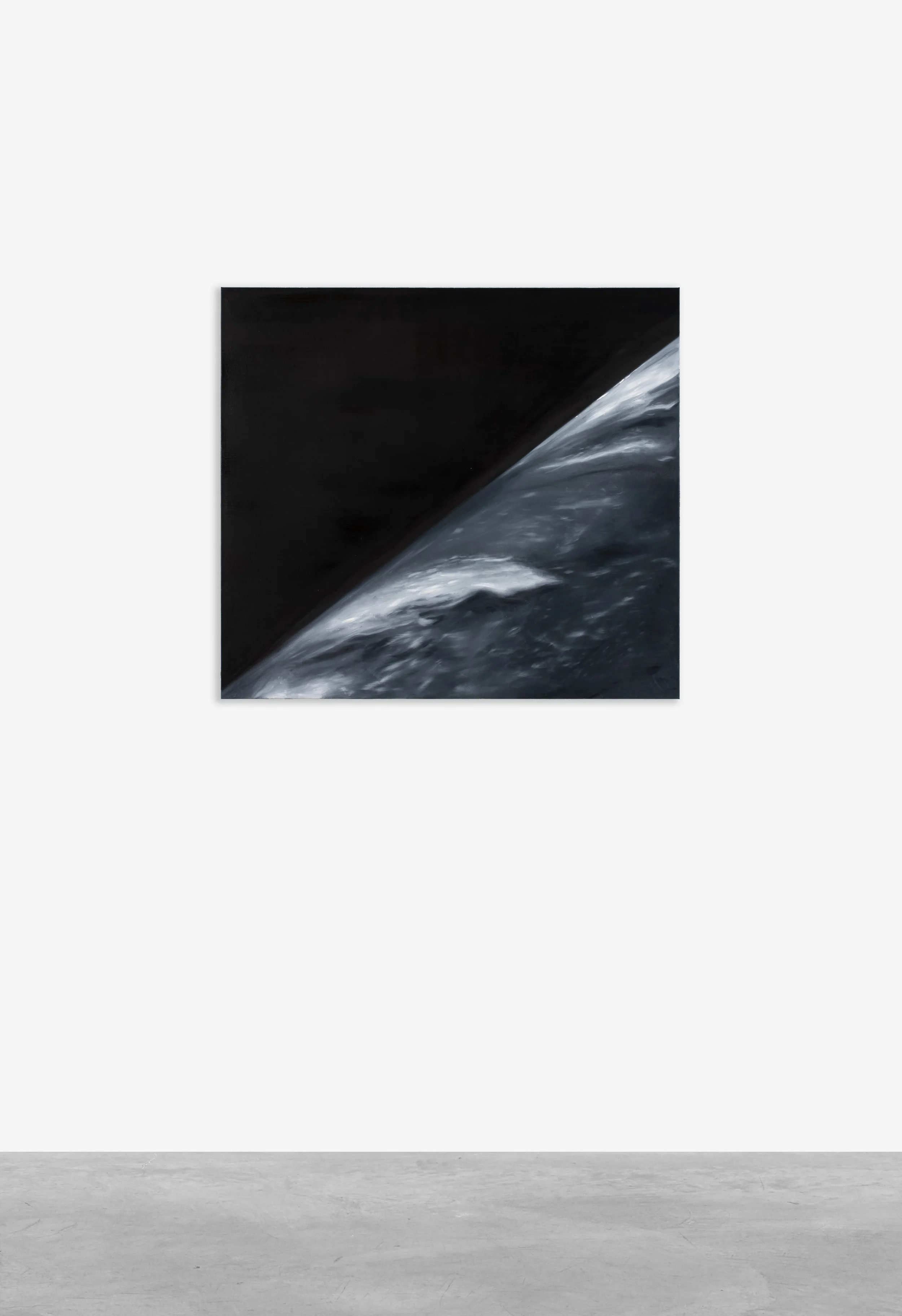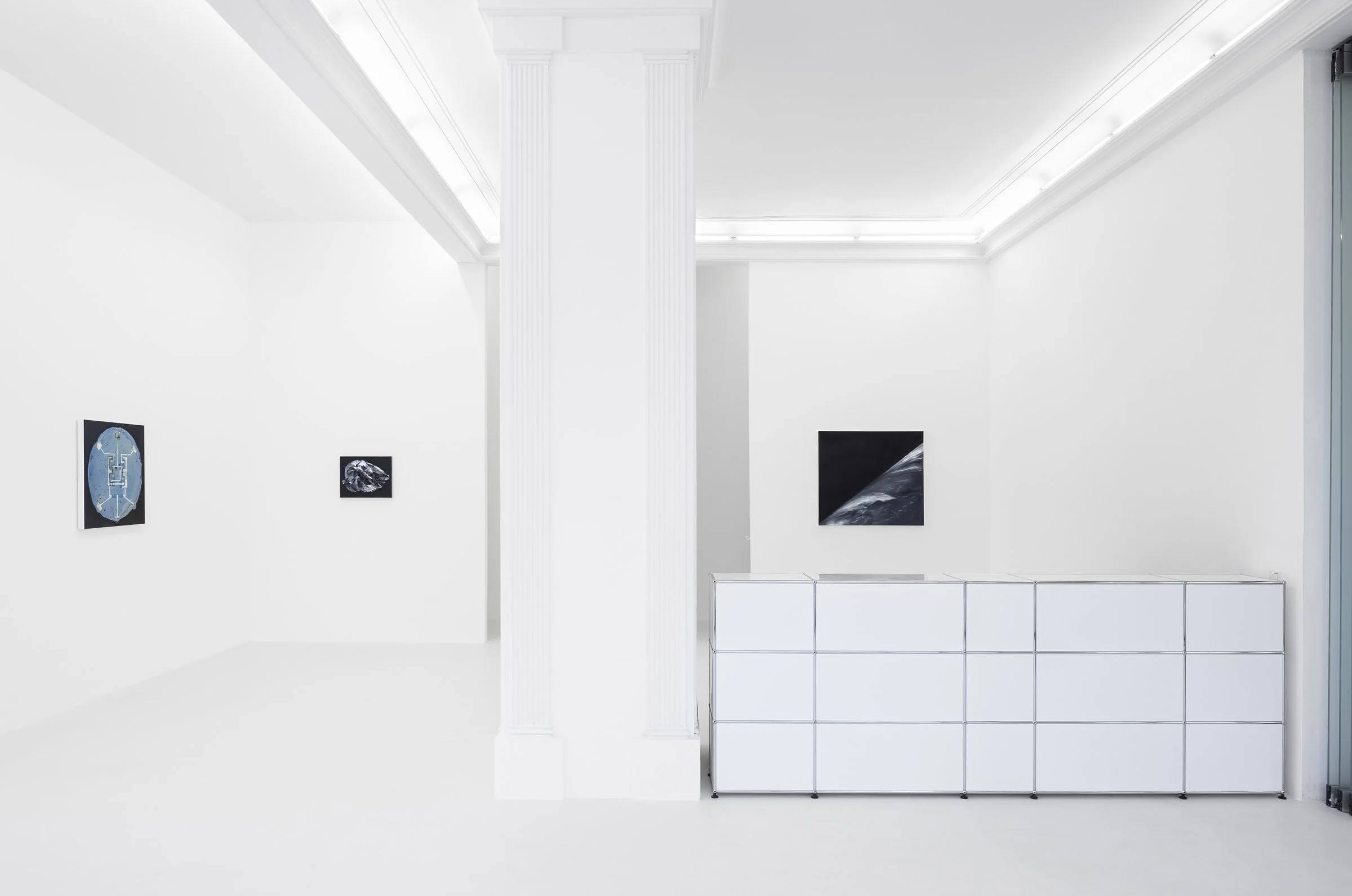Peek, 2021
Peek, 2021
Oil on linen
91 x 102 cm (36 x 40 in)
Dawn, Peres Projects, Berlin, 2022
Dawn, Peres Projects, Berlin, 2022
Peek (2021) is a painting that reimagines the first photograph ever taken from space. On October 24, 1946, the V-2 No. 13 rocket was launched from the White Sands Missile Range in New Mexico, reaching an altitude of 65 miles. This rocket captured the Earth from space, marking the first time humanity glimpsed our planet against the vast, dark expanse of the cosmos. It took photographs every 1.5 seconds, at a speed five times faster than any previous camera. Peek (2021) pays homage to this historic image, which also serves as the genesis of Tan Mu's Horizon series—an exploration of Earth's satellite perspective. By recreating the hazy, black-and-white photograph, Tan Mu draws inspiration from the same sense of wonder, delving into the process of human activity and the ever-changing world. The work reflects on technology as an extension of the human body and the fundamental motivations behind what we seek to achieve.
Q: How does space photography, as a medium, influence your work, particularly in Peek?
Space photography plays a crucial role in my work, especially in Peek. It’s fascinating to think that photography has become an integral part of space exploration. Today, astronauts at the International Space Station (ISS) are trained not only to conduct scientific experiments but also to capture images of Earth and beyond. These photographs reveal so much—not just about distant planets but also about our own planet. From storms and ice caps to geological and meteorological features, these images offer a unique perspective that transforms how we see and understand Earth. It’s not just about capturing beauty; it’s about revealing the hidden complexities of our world and our place within the cosmos. Space photography, in a way, bridges the gap between science and art, offering both knowledge and inspiration.
Q: How does Peek reflect the relationship between technology and human perception?
Tan Mu': Peek is deeply rooted in the idea of technology as an extension of the human body, particularly the eye. The first space photograph was made possible by advancements in rocket and camera technology, allowing us to see Earth in a way that was previously unimaginable. This act of capturing the planet from space not only expanded our visual capabilities but also shifted our perspective on our place in the universe. In Peek, I wanted to explore how technology enhances our ability to observe and interpret the world, revealing details and patterns that are otherwise hidden. The painting reflects on the fundamental motivations behind such technological achievements—what drives us to see more, to explore further, and to understand our world from new vantage points.
Q: How does Peek connect to the broader themes of your Horizon series and other works like Embryo (2022)?
Tan Mu: Peek is the genesis of my Horizon series, which explores Earth from a satellite perspective and examines how technology allows us to see the world in new ways. This theme is also present in Embryo (2022), where I use the perspective of the microscope to depict the beginnings of life. Both works reflect on how technology enhances our vision, whether it’s by capturing the Earth from space or revealing the intricate details of cellular structures. Technology acts as an extension of the human body, enabling us to reach into both the microscopic and macroscopic worlds. Through microscopes, we can observe atoms, cells, and DNA—realms invisible to the naked eye—and even edit genes. Through telescopes and satellite imagery, we can observe the world beyond the horizon and touch the edges of the observable universe. These tools allow us to explore and redefine our understanding of life and existence. Together, these works form a dialogue about the intersection of technology, perception, and the human desire to explore and redefine our world. They remind us that technology is not just a tool but a bridge that connects us to the vastness of the cosmos and the intricacies of life itself.
Q: How does the satellite perspective in Peek contribute to the themes of tranquility and introspection in your work?
Tan Mu: The satellite perspective in Peek creates a sense of distance and elevation, which I believe fosters an atmosphere of tranquility and introspection. When we view the Earth from above, we are removed from the immediacy of our daily lives and can see the broader picture. This elevated viewpoint allows us to reflect on the interconnectedness of all things and the hidden complexities of our world. In Peek, the hazy, black-and-white rendering of the Earth emphasizes this meditative quality, inviting viewers to pause and contemplate the significance of what they are seeing. It’s a reminder that sometimes, stepping back and gaining a new perspective can reveal deeper truths about ourselves and our environment.





